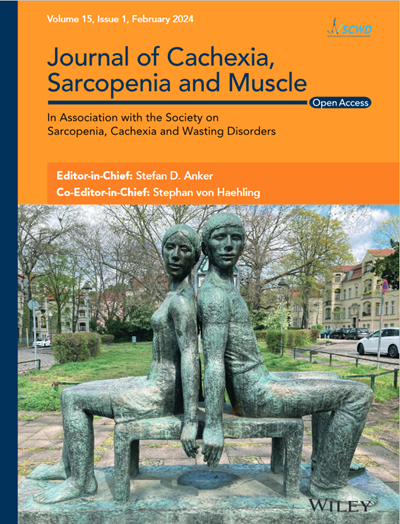Muscle size and density are independently associated with death after hip fracture: A prospective cohort study
Abstract
Background
Mortality following hip fracture is high and incompletely understood. We hypothesize that hip musculature size and quality are related to mortality following hip fracture. This study aims to investigate the associations of hip muscle area and density from hip CT with death following hip fracture as well as assess the dependence of this association on time after hip fracture.
Methods
In this secondary analysis of the prospectively collected CT images and data from the Chinese Second Hip Fracture Evaluation, 459 patients were enrolled between May 2015 and June 2016 and followed up for a median of 4.5 years. Muscle cross-sectional area and density were measured of the gluteus maximus (G.MaxM) and gluteus medius and minimus (G.Med/MinM) and aBMD of the proximal femur. The Goutallier classification (GC) was used for qualitatively assessing muscle fat infiltration. Separate Cox models were used to predict mortality risk adjusted for covariates.
Results
At the end of the follow-up, 85 patients were lost, 81 patients (64% women) had died, and 293 (71% women) survived. The mean age of non-surviving patients at death (82.0 ± 8.1 years) was higher than that of the surviving patients (74.4 ± 9.9 years). The Parker Mobility Score and the American Society of Anesthesiologists scores of the patients that died were respectively lower and higher compared to the surviving patients. Hip fracture patients received different surgical procedures, and no significant difference in the percentage of hip arthroplasty was observed between the dead and the surviving patients (P = 0.11). The cumulative survival was significantly lower for patients with low G.MaxM area and density and low G.Med/MinM density, independent of age and clinical risk scores. The GC grades were not associated with the mortality after hip fracture. Muscle density of both G.MaxM (adj. HR 1.83; 95% CI, 1.06–3.17) and G.Med/MinM (adj. HR 1.98; 95% CI, 1.14–3.46) was associated with mortality in the 1st year after hip fracture. G.MaxM area (adj. HR 2.11; 95% CI, 1.08–4.14) was associated with mortality in the 2nd and later years after hip fracture.
Conclusion
Our results for the first time show that hip muscle size and density are associated with mortality in older hip fracture patients, independent of age and clinical risk scores. This is an important finding to better understand the factors contributing to the high mortality in older hip fracture patients and to develop better future risk prediction scores that include muscle parameters.

 求助内容:
求助内容: 应助结果提醒方式:
应助结果提醒方式:


